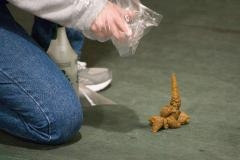Housesoiling

Housesoiling is a spatial problem. Your puppydog has been allowed to eliminate in the wrong place. Housesoiling quickly becomes a bad habit because dogs develop strong location, substrate, and olfactory preferences for their improvised indoor toilet areas. To housetrain your puppydog: first, prevent any more mistakes; and second, teach your puppydog where you would like him to eliminate.
Prevent Mistakes
Mistakes are a disaster since they set a bad precedent and create bad habits, which can be hard to break. Consequently, you must prevent mistakes at all cost. Whenever you are not at home, leave your dog in a long-term confinement area, such as a single room indoors with easy-to-clean floors (bathroom, kitchen, or utility room)—this will be your puppydog’s playroom.
Provide your dog with fresh water, a number of stuffed chewtoys for entertainment, a comfortable bed in one corner, and a doggy toilet in the corner diagonally opposite from his bed. Your dog will naturally want to eliminate as far as possible from his bed, and so will soon develop the good habit of using his toilet. And remember, good habits are just as hard to break as bad habits.
For a doggy toilet, use sheets of newspaper sprinkled with soil, or a litter box filled with a roll of turf, or a concrete paving slab. Thus your dog will develop olfactory and substrate preferences for eliminating on soil, grass, or concrete.
The purpose of long-term confinement is to confine your dog’s natural behaviors (including urinating and defecating) to an area that is protected (thus preventing any mistakes around the house when you are not there), and to help your dog quickly develop a strong preference for eliminating on soil, grass, or concrete.
Teach Your Dog to Eliminate in the Right Place
When you are at home, confine your dog to a short-term confinement area with a number of stuffed chewtoys for entertainment. A portable dog crate makes an ideal doggy den. Alternatively, keep your dog on a short leash fastened to an eye-hook in the base board near her bed, or attach the leash to your belt. This way your dog may settle down beside you while you read, work at the computer, or watch television.
Every hour on the hour, say "Let’s go pee and poop" (or some other appropriate toilet instruction), and hurry your dog (on leash) to her toilet (in your yard, or at curbside outside the front door of your house or apartment building). Stand still with your dog on leash and repeat the instruction to eliminate. Give your dog three minutes to empty herself.
When your dog eliminates, praise her enthusiastically and offer three freeze-dried liver treats. Most puppies will urinate within two minutes on each trip to a toilet area, and defecate within three minutes on every other trip. Once your dog realizes that she can cash in her urine and feces for tasty treats, she will want to eliminate in her toilet area. Soiling the house just does not have comparable fringe benefits. Moreover, after a dozen or so repetitions, you will have taught your dog to eliminate on command.
If your dog does not eliminate during the allotted three-minute toilet break, put her back inside her crate for another hour.
The purpose of short-term close confinement is to prevent any mistakes around the house when you are home (but cannot devote undivided attention to your dog) and to predict when your dog needs to eliminate. Temporarily (for no more than an hour at a time) confining a puppydog to a small space (e.g., a dog crate) inhibits elimination, since the dog does not want to soil her sleeping area. Consequently, your dog will want to go immediately upon release from confinement—especially since hurrying to the toilet area will jiggle her bladder and bowels. Since you choose when to release your dog, you may choose when your puppy eliminates, and since you can predict when your dog needs to eliminate, you may be there to show her where to go, to reward your dog for going, and to inspect and immediately clean up after your dog.
Never confine a puppy or an unhousetrained adult dog to a crate for longer than an hour. A dog confined too long will be forced to soil her crate, making her extremely difficult to housetrain.
Once your pup is old enough to go on walks, make sure she eliminates (in the yard, or in front of your house) before each walk. If your dog does not go within three minutes, put her back in her crate and try again an hour later. However, if your dog does go, praise and reward her as usual and then say “Let’s go for a walk.” With a no-feces/no-walk policy, you will soon have a very speedy defecator. Moreover, elimination close to home facilitates clean-up and disposal; you will not have to stroll the neighborhood weighed down with a bag of doggie doo.
If you require a more detailed description of housetraining, download BEFORE You Get Your Puppy. To housetrain your dog, you need a dog crate, a number of chewtoys, and some freeze-dried liver treats. All of these products are available from your local pet store.




